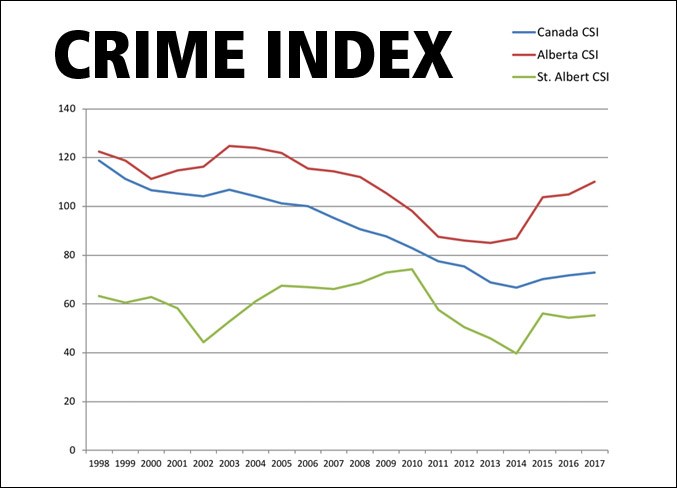The severity of violent crimes in St. Albert went up by 23 per cent in 2017, but the city continues to have the lowest crime severity index among cities across the province.
The crime severity index (CSI), released earlier this week by Statistics Canada, helps to track crime trends across the country. It looks at the overall seriousness of the crime and weights offences by incarceration rates and the average length of jail sentences.
In 2017, St. Albert's crime severity index saw a small rise of 1.56 per cent, far less than the provincial increase of more than 4.63 per cent and below the federal increase of 1.62 per cent.
However, St. Albert trended toward crimes that were more violent last year. While the severity index for non-violent crimes dropped by 2.97 per cent, the severity index for violent crimes jumped by 23 per cent for a score of 42.23, compared to a 4.63-per-cent provincial increase to 96.3 and a federal increase of 4.85 per cent to 80.3.
But St. Albert RCMP Insp. Pamela Robinson said an increase in the violent crime severity index isn't a reflection of public safety.
"Although the crime severity index is useful in identifying our trends ... it doesn't tell the whole story. Community safety is a community issue and it should be measured by our public perception, and not on our statistics alone," she said.
Speaking of the public, the amount of people reporting suspicious activity in St. Albert more than doubled in 2017, and police say that shows education and prevention measures could be paying off.
Robinson said the RCMP received 691 reports of suspicious persons, vehicles and property in 2017 – up from 325 in 2016.
"The community adopting the approach of safety as a community issue, not just a police issue – and that they're assisting and aiding us – is working," Robinson said.
"Our detachment members regularly go above and beyond in enforcement and education strategies to support and serve our community."
More reporting, coupled with proactive work by officers to ask the public for assistance and work together with community partners to understand why crimes are happening are factors that probably helped keep the city's overall CSI low in 2017.
A look at criminal violence in St. Albert
Comparing statistics of violent crimes over the years, Robinson said the majority of the crime increases St. Albert RCMP see are offences where the offender and the victim are known to each other.Those offences, often related to domestic violence, can include violations such as criminal harassment or uttering threats.
Incidents of criminal harassment jumped in 2017 from 34 to 44, while there were 81 instances of uttering threats – the same as in 2016.
Robinson said an increase in occurrences could mean several things and doesn't necessarily mean there is an increase in that particular crime.
"It could mean a greater support within the community, where victims now feel comfortable coming forward because they know how to get help and where to get help," she said.
One of the factors tipping the scale last year was a homicide, which is being prosecuted as a first-degree murder – the heaviest-weighted offence on the books. By comparison, St. Albert did not record any homicides in 2016.
Robinson said firearms violations also increased in 2017, adding that could be related to the RCMP's approach as well.
"An increase could also show an increase in enforcement and proactive activity of the police," she said.
Robberies also increased from 10 in 2016 to 14 in 2017.
While aggravated assault statistics rose from three in 2016 to six in 2017, Robinson said St. Albert saw a cumulative six-per-cent drop in assaults. General assaults in particular dropped from 222 incidents in 2016 to 190 in 2017.
Sexual assaults also dropped from 25 in 2016 to 23 in 2017.
Sexual violations against children dropped from 12 in 2016 to 10 in 2017.
On the less-violent side, St. Albert saw a spike in impaired driving in 2017, from 147 offences to 172. In a July 27 news release, St. Albert RCMP stated alcohol-impaired driving decreased but drug-impaired driving rose.
"Increased enforcement for impaired driving and other traffic safety matters remain a priority in St. Albert," the news release stated.




